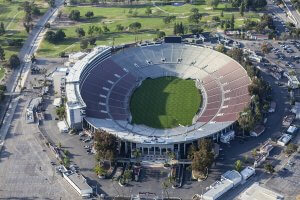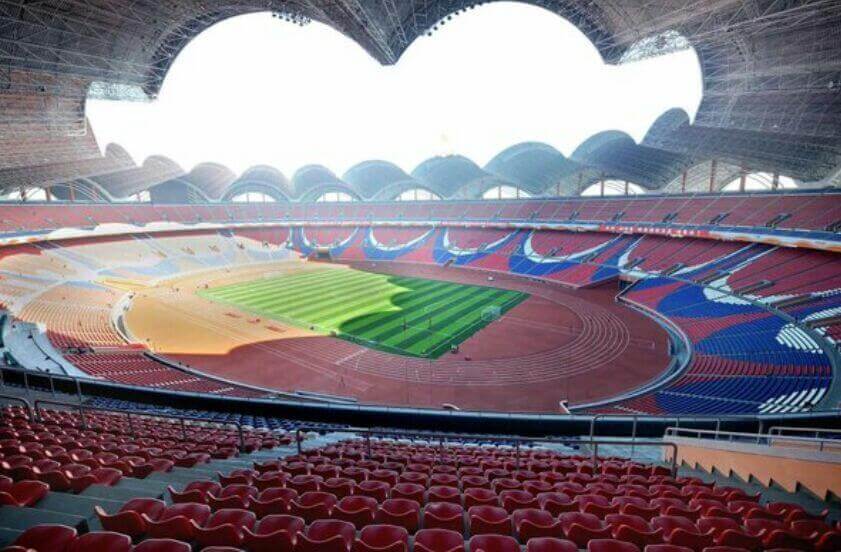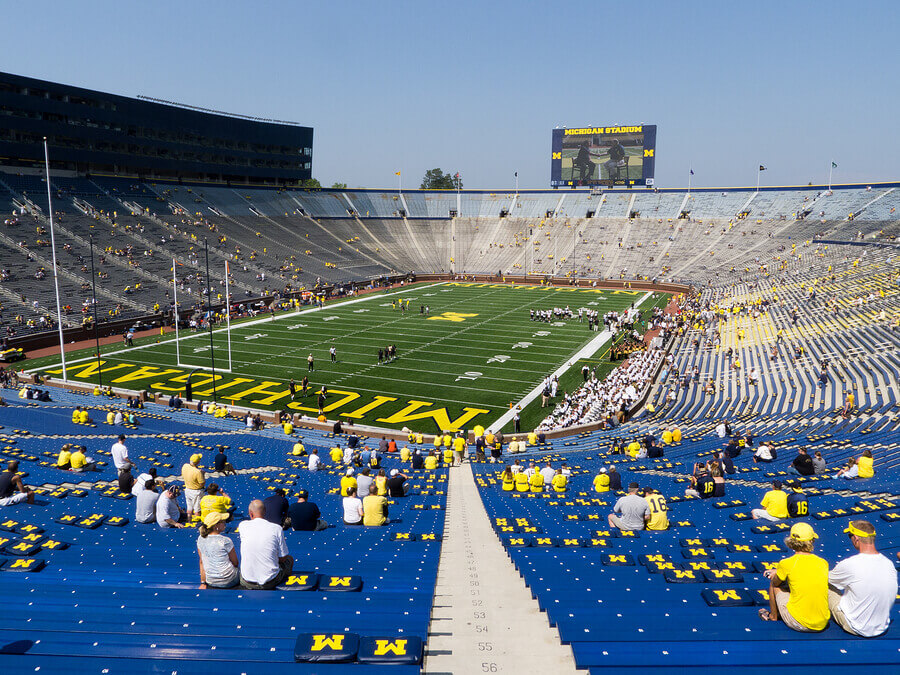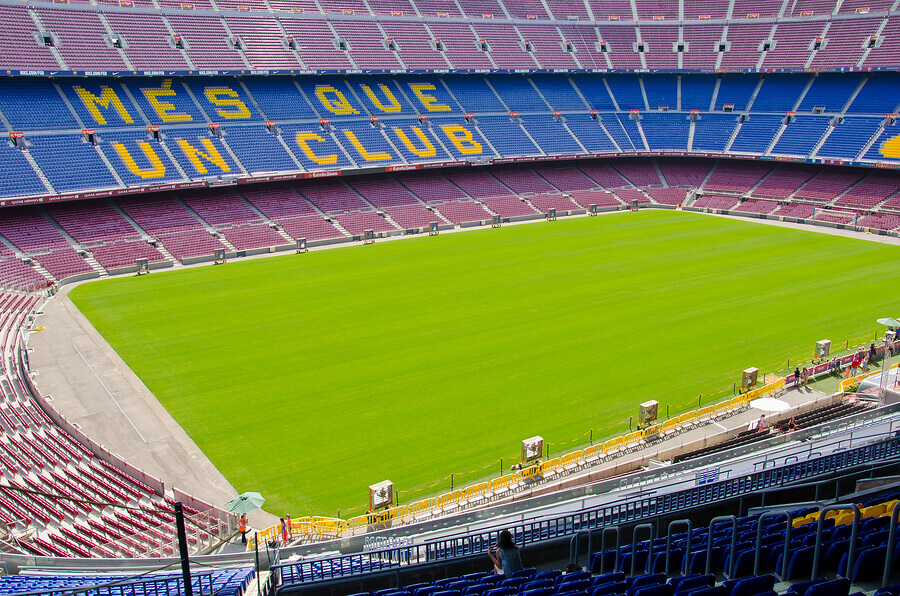The 6 Biggest Stadiums in the World

Some stadiums are more famous than others and have been venues for huge events. But the lesser-known stadiums also have impressive capacities and deserve some recognition. How many of them do you know?
The biggest stadiums in the world
You won’t believe some of the stadiums on this list. Keep reading to find out where they all are!
1. Rungrado 1st of May Stadium
Big name, big capacity: this stadium accommodates no less than 114,000 fans. As of today, it’s the biggest stadium in the world and is located in Pyongyang, North Korea. The stadium boasts eight floors and 16 rooftop areas under the arched roof that resembles a flower.
The name “Rungrado 1st of May” comes from two sources: first, Rungrado is the name of the island where it stands.

Second, the 1st of May marks International Labor Day. While it might look like an ultra-modern stadium, it was built in 1989 and aside from soccer, it hosts track and field events as well.
2. Michigan Stadium: The Big House
Home of the Michigan Wolverines (University of Michigan, United States), the Big House is one of the biggest stadiums in the world with a capacity of 107,601 fans.
While football games normally take place here, the stadium also made international headlines in 2014 when it hosted a friendly match between Real Madrid and Manchester United in the International Champions Cup.

The University of Michigan owns the stadium and constructed it in 1927, expanding it in 2010.
3. One of the biggest stadiums in the world: Camp Nou
Camp Nou isn’t only one of the biggest stadiums in the world, but also one of the most famous. Home of the F.C. Barcelona, the stadium fits 99,354 fans and is considered by UEFA to be one of the most elite stadiums.

Camp Nou, or “new field”, was inaugurated in 1957 and stands in the Les Corts district in Barcelona. The stadium has also hosted several international games for the Spanish national team, 1964 Eurocup, 1982 FIFA World Cup, UEFA Champions League finals, and UEFA Cup Winners’ Cup.
4. Soccer City
Inaugurated in 1989, this 94,736-person capacity stadium is where official games of the South Africa national team take place. In addition, it’s also where the team Kaizer Chiefs play their games. Soccer City is located in Johannesburg and was one of the stadiums of the 2010 World Cup, which took place one year after its renovation.

Soccer City has also been the venue for various musical events. Among the artists and groups who’ve performed, there’s U2, the Red Hot Chili Peppers, the Foo Fighters, Michael Jackson and Metallica.
5. Rose Bowl Stadium
The Rose Bowl stadium will soon turn 100 years old– it was first inaugurated in 1922– and boasts the title of one of the biggest stadiums in the world. It accommodates 92,541 fans.
Located in Pasadena, Los Angeles, it’s currently the home of the UCLA Bruins. But in its long history, it’s hosted athletic events for two Olympics (1932 and 1984), the Super Bowl, the 1994 FIFA World Cup, and the CONCACAF Gold Cup.
6. One of the biggest stadiums in the world: Wembley
Not only is the Wembley stadium one of the biggest in the world, but it’s also one of the most legendary. It stands in London and was inaugurated in 2007, on the same spot where the old stadium once stood since 1923. It hosted some of the athletic events of the 2012 Olympic Games.

Built to fit 90,000 fans, it belongs to the British government and it’s where the national team plays. During its construction, the Tottenham Hotspurs soccer team used the stadium. In addition, the stadium has also hosted football games and musical events.
To continue the top 10 list of the biggest stadiums in the world, we have to include the Gelora Bung Karno Stadium (Jakarta, Indonesia: 88,306 capacity). The Bukit Jalil Stadium (Kuala Lumpur, Malaysia: 87,411 capacity). The Azteca Stadium (Mexico City: 87,000 capacity). And the Lusail Iconic Stadium (Qatar: 86,000 fans–currently still under construction). Which is your favorite?
Some stadiums are more famous than others and have been venues for huge events. But the lesser-known stadiums also have impressive capacities and deserve some recognition. How many of them do you know?
The biggest stadiums in the world
You won’t believe some of the stadiums on this list. Keep reading to find out where they all are!
1. Rungrado 1st of May Stadium
Big name, big capacity: this stadium accommodates no less than 114,000 fans. As of today, it’s the biggest stadium in the world and is located in Pyongyang, North Korea. The stadium boasts eight floors and 16 rooftop areas under the arched roof that resembles a flower.
The name “Rungrado 1st of May” comes from two sources: first, Rungrado is the name of the island where it stands.

Second, the 1st of May marks International Labor Day. While it might look like an ultra-modern stadium, it was built in 1989 and aside from soccer, it hosts track and field events as well.
2. Michigan Stadium: The Big House
Home of the Michigan Wolverines (University of Michigan, United States), the Big House is one of the biggest stadiums in the world with a capacity of 107,601 fans.
While football games normally take place here, the stadium also made international headlines in 2014 when it hosted a friendly match between Real Madrid and Manchester United in the International Champions Cup.

The University of Michigan owns the stadium and constructed it in 1927, expanding it in 2010.
3. One of the biggest stadiums in the world: Camp Nou
Camp Nou isn’t only one of the biggest stadiums in the world, but also one of the most famous. Home of the F.C. Barcelona, the stadium fits 99,354 fans and is considered by UEFA to be one of the most elite stadiums.

Camp Nou, or “new field”, was inaugurated in 1957 and stands in the Les Corts district in Barcelona. The stadium has also hosted several international games for the Spanish national team, 1964 Eurocup, 1982 FIFA World Cup, UEFA Champions League finals, and UEFA Cup Winners’ Cup.
4. Soccer City
Inaugurated in 1989, this 94,736-person capacity stadium is where official games of the South Africa national team take place. In addition, it’s also where the team Kaizer Chiefs play their games. Soccer City is located in Johannesburg and was one of the stadiums of the 2010 World Cup, which took place one year after its renovation.

Soccer City has also been the venue for various musical events. Among the artists and groups who’ve performed, there’s U2, the Red Hot Chili Peppers, the Foo Fighters, Michael Jackson and Metallica.
5. Rose Bowl Stadium
The Rose Bowl stadium will soon turn 100 years old– it was first inaugurated in 1922– and boasts the title of one of the biggest stadiums in the world. It accommodates 92,541 fans.
Located in Pasadena, Los Angeles, it’s currently the home of the UCLA Bruins. But in its long history, it’s hosted athletic events for two Olympics (1932 and 1984), the Super Bowl, the 1994 FIFA World Cup, and the CONCACAF Gold Cup.
6. One of the biggest stadiums in the world: Wembley
Not only is the Wembley stadium one of the biggest in the world, but it’s also one of the most legendary. It stands in London and was inaugurated in 2007, on the same spot where the old stadium once stood since 1923. It hosted some of the athletic events of the 2012 Olympic Games.

Built to fit 90,000 fans, it belongs to the British government and it’s where the national team plays. During its construction, the Tottenham Hotspurs soccer team used the stadium. In addition, the stadium has also hosted football games and musical events.
To continue the top 10 list of the biggest stadiums in the world, we have to include the Gelora Bung Karno Stadium (Jakarta, Indonesia: 88,306 capacity). The Bukit Jalil Stadium (Kuala Lumpur, Malaysia: 87,411 capacity). The Azteca Stadium (Mexico City: 87,000 capacity). And the Lusail Iconic Stadium (Qatar: 86,000 fans–currently still under construction). Which is your favorite?
All cited sources were thoroughly reviewed by our team to ensure their quality, reliability, currency, and validity. The bibliography of this article was considered reliable and of academic or scientific accuracy.
- Harrington, P. J. (2004). Building Wembley – A stadium for the future. Concrete (London).
This text is provided for informational purposes only and does not replace consultation with a professional. If in doubt, consult your specialist.








